Dai
Introduction
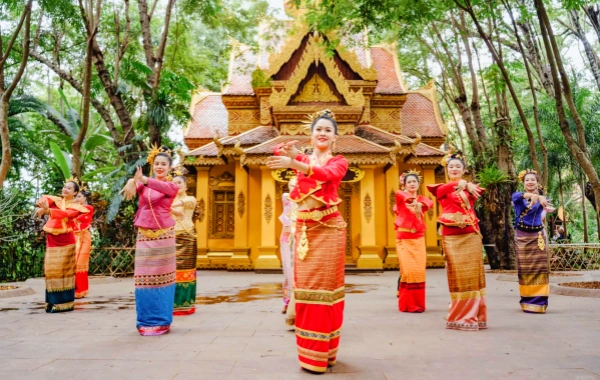
The Dai Nationality is a vibrant and culturally rich ethnic group in China, well - known for its unique traditions, exquisite costumes, and charming dance and music. Living in the warm and humid regions of southern Yunnan, the Dai people have developed a lifestyle closely intertwined with the lush tropical and subtropical environment.
 History
History
· Origin
The ancestors of the Dai people are believed to have originated from the ancient Baiyue tribes in southern China. Over a long period of migration and settlement, they gradually formed their own distinct ethnic identity in the areas of present - day Yunnan.
· Development
During the historical development, the Dai areas established their own local political entities. They had relatively independent administrative systems and cultural traditions. The spread of Theravada Buddhism in the Dai regions during the Tang and Song dynasties had a profound impact on their social structure, culture, and art. Monasteries became important centers for education, culture, and art, playing a crucial role in the development of the Dai society.
· Modern Times
In modern times, the Dai people have actively participated in the national construction and development. With the improvement of transportation and communication, the Dai culture has gained wider recognition and dissemination. At the same time, they have also faced challenges such as the impact of modernization on traditional culture. However, through various efforts, including cultural protection projects and tourism development, the Dai people have managed to preserve and promote their unique cultural heritage.
 Population
Population
· Quantity
As of the latest census data, the Dai population in China is approximately 1,329,000, making it one of the larger ethnic minorities in the country.
· Distribution
The Dai people are mainly concentrated in Yunnan Province, especially in Xishuangbanna Dai Autonomous Prefecture and Dehong Dai and Jingpo Autonomous Prefecture. These areas are characterized by tropical and subtropical climates, rich natural resources, and diverse ecosystems, which have provided favorable conditions for the survival and development of the Dai people. The relatively concentrated distribution has also contributed to the preservation and inheritance of their unique cultural traditions.
 Economy
Economy
Traditionally, the Dai economy was based on wet - rice cultivation. The fertile plains and abundant water resources in the Dai regions were ideal for growing rice. In addition to agriculture, fishing, forestry, and handicrafts also played important roles in their economy. In modern times, with the development of tourism, the Dai areas have gradually developed a tourism - based economy. The unique Dai culture, beautiful natural landscapes, and traditional festivals have attracted a large number of tourists, providing new sources of income for the local people. At the same time, the development of modern agriculture, such as the cultivation of tropical fruits and specialty crops, has also contributed to the economic growth of the Dai regions.
 Culture
Culture
· Language and Script
The Dai language belongs to the Tai - Kadai language family. There are different dialects among the Dai people, such as the Xishuangbanna Dai dialect and the Dehong Dai dialect. The Dai people have their own written script, which has a long history and is mainly used for religious texts, literature, and historical records. The script is based on the Indian Brahmi script and has undergone continuous development and improvement over time. In recent years, efforts have been made to promote the use and study of the Dai language and script through education and cultural programs.
· Religious Beliefs
Theravada Buddhism is the predominant religion of the Dai Nationality. Monasteries are important religious and cultural centers in the Dai communities. Young boys often enter monasteries to receive religious education and learn Buddhist scriptures. Buddhism has a profound influence on the Dai people's moral values, social behavior, and art. In addition to Buddhism, some Dai people also practice animism and ancestor worship, believing in the existence of spirits in nature and showing respect for their ancestors.
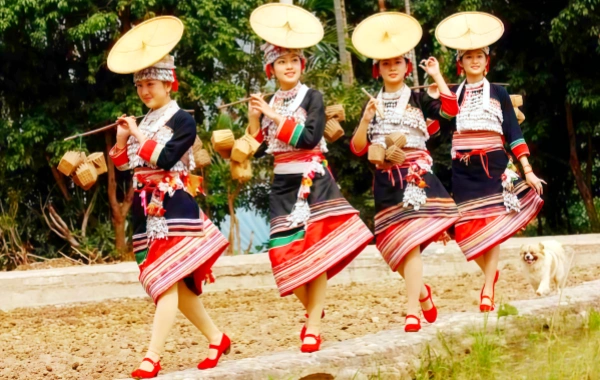 · Clothing
· Clothing
Traditional Dai clothing is colorful and distinctive. Women usually wear tight - fitting upper garments and long, flowing skirts. The skirts are often made of brightly colored fabrics with intricate patterns. They also wear elaborate headpieces and jewelry, such as silver earrings, necklaces, and bracelets. Men typically wear short - sleeved shirts and long trousers, often made of cotton or silk. Both men and women wear sandals or traditional shoes made of local materials. The clothing not only reflects the aesthetic taste of the Dai people but also has practical functions suitable for the local climate.
· Agriculture
Wet - rice cultivation is the cornerstone of traditional Dai agriculture. The Dai people have developed a set of sophisticated farming techniques adapted to the local environment. They build complex irrigation systems to ensure a stable water supply for the rice fields. In addition to rice, they also grow a variety of crops, such as sugarcane, tea, and tropical fruits. Agriculture is not only a means of livelihood but also an important part of Dai culture, with many agricultural - related festivals and rituals.
· Literature
Dai literature has a rich oral tradition, including folk tales, legends, epics, and songs. These oral works are passed down from generation to generation, reflecting the history, beliefs, and values of the Dai people. In addition, there is also a written literature based on the Dai script, mainly consisting of religious texts, historical records, and poems. In recent years, there have been efforts to collect, translate, and publish Dai literature, making it more accessible to a wider audience.
· Transportation
Traditionally, the Dai people used water transportation as an important means of getting around, especially in the river - rich areas. Boats and rafts made of local materials were commonly used for fishing, transportation of goods, and travel. In mountainous areas, horses and mules were used for land transportation. In modern times, with the development of infrastructure, modern modes of transportation such as cars, buses, and motorcycles have become more common. However, traditional transportation methods are still used in some remote areas and during festivals and cultural activities.
 Science
Science
· Medicine
Traditional Dai medicine has a long history and is based on a combination of natural remedies, spiritual practices, and empirical knowledge. Dai healers use a variety of herbs, plants, and animal parts to treat different diseases. They also believe in the balance of the body's energy and use techniques such as massage and acupuncture to restore health. In recent years, there has been growing interest in integrating traditional Dai medicine with modern healthcare systems to provide more comprehensive and culturally appropriate medical services.
· Calendar
The Dai people have their own traditional calendar, which is based on the lunar cycle and agricultural seasons. The calendar is used to guide agricultural activities, such as planting and harvesting, as well as to mark important festivals and religious ceremonies. Although the modern solar calendar is widely used in daily life, the traditional Dai calendar still plays an important role in preserving and传承 (here, "传承" can be translated as "passing down" or "preserving the tradition of") Dai culture.
 Art
Art
· Music
Dai music is characterized by its melodious tunes and rhythmic patterns. Traditional Dai musical instruments include the elephant - foot drum, the bronze gong, and the bamboo flute. The elephant - foot drum is a large drum shaped like an elephant's foot and is often used in religious ceremonies and festivals. Dai songs often express love, nature, and daily life, with beautiful lyrics and enchanting melodies. Music is an integral part of Dai culture, bringing people together and creating a joyful atmosphere.
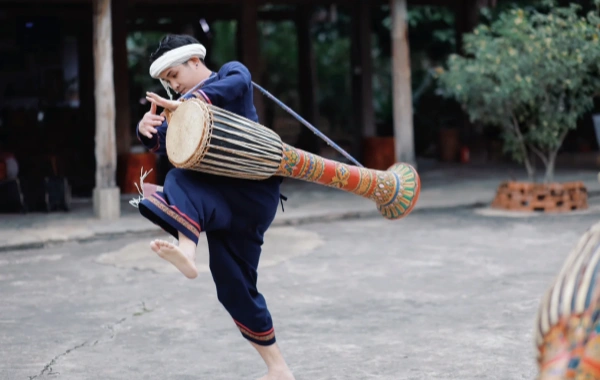 · Dance
· Dance
Dai dance is known for its graceful movements and vibrant expressions. The famous "Peacock Dance" is a representative Dai dance, which mimics the movements of a peacock, symbolizing beauty, happiness, and good luck. Other traditional dances include the "Drum Dance" and the "Fishing Dance", each reflecting different aspects of Dai life and culture. Dance performances are often held during festivals and celebrations, showcasing the artistic talents and cultural heritage of the Dai people.
· Architecture
Traditional Dai architecture is well - adapted to the local tropical and subtropical climate. Dai houses are usually built on stilts to prevent flooding and improve ventilation. The roofs are often sloped and covered with thatch or tiles to shed rainwater. The interior of the house is divided into different functional areas, such as living rooms, bedrooms, and kitchens. In addition to residential buildings, Dai monasteries are also important architectural landmarks, featuring unique Buddhist - style designs and exquisite carvings.
· Landscape
The Dai landscape is dominated by lush tropical rainforests, clear rivers, and beautiful lakes. Xishuangbanna, in particular, is known as a "paradise on earth" with its rich biodiversity and stunning natural scenery. The natural beauty of the Dai regions has inspired many artists and poets, who have created numerous works of art to express their admiration for this land. The forests are home to a wide variety of plants and animals, providing a natural treasure trove for the Dai people and a unique ecological environment for the world.
· Arts and Crafts
Dai arts and crafts are renowned for their exquisite craftsmanship and unique styles. Traditional Dai crafts include silverware, wood - carving, and batik. Dai silverware is famous for its delicate patterns and high - quality craftsmanship, often used as jewelry or decorative items. Wood - carving is used to create figures, animals, and religious objects, showcasing the artistic skills of the Dai craftsmen. Batik is a traditional dyeing technique that produces beautiful and unique patterns on fabrics, which are then used to make clothing, tablecloths, and other items. These arts and crafts not only have aesthetic value but also carry the cultural traditions and historical memories of the Dai people.
 Custom
Custom
· Etiquette
Dai etiquette is based on respect, hospitality, and politeness. When visiting a Dai home, guests are usually greeted with a warm smile and offered tea or other refreshments. It is customary to remove one's shoes before entering the house as a sign of respect. The Dai people also place great importance on social harmony and avoiding conflict. They use gentle language and polite gestures in communication, showing respect for others' opinions and feelings.
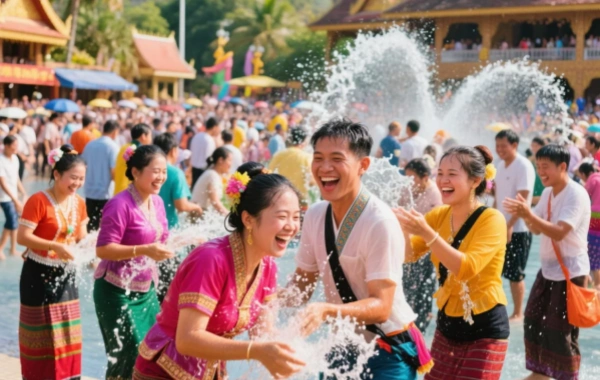
· Marriage Customs
Dai marriage customs vary slightly among different regions but generally involve several steps. The process usually starts with the proposal, where the boy's family sends a matchmaker to the girl's family to express their intentions. If the girl's family agrees, an engagement ceremony is held, during which gifts are exchanged between the two families. The wedding ceremony is a grand event, often lasting for several days. It includes various rituals, such as the blessing of the newlyweds by elders and monks, and a feast for relatives and friends. After the wedding, the newlyweds may live with the groom's family or establish their own household.
· Festivals
The Dai people celebrate many important festivals throughout the year. The Water - Splashing Festival is the most famous and well - known Dai festival, which is held in mid - April to celebrate the New Year. During the festival, people splash water on each other as a symbol of blessing and good luck. Other festivals include the Door - Closing Festival and the Door - Opening Festival, which are related to religious beliefs and agricultural activities. These festivals are marked by feasting, dancing, and traditional games, bringing people together and strengthening community bonds.
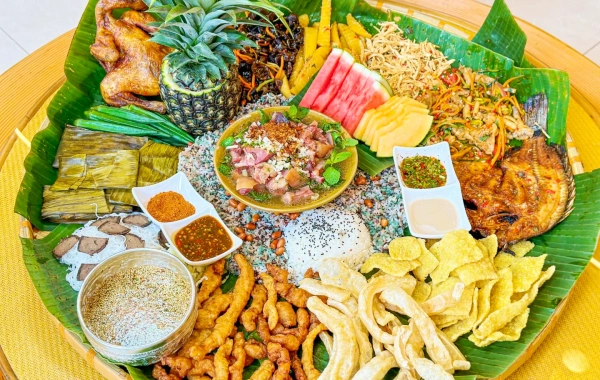 · Diet
· Diet
Dai cuisine is characterized by its unique flavors and use of local ingredients. Sticky rice is a staple food, often eaten with various dishes. Common ingredients include fresh vegetables, fish, shrimp, and tropical fruits. Dai dishes are known for their sour, spicy, and fragrant tastes, which are achieved through the use of special seasonings such as lemon grass, chili, and fish sauce. Some famous Dai dishes include "Lemon Squid" and "Spicy Chicken with Bamboo Shoots". In addition to regular meals, the Dai people also have a tradition of making and sharing snacks during festivals and special occasions.
· Funeral Customs
Dai funeral customs are influenced by both Buddhism and traditional beliefs. When a person dies, the body is usually washed and dressed in new clothes. A funeral ceremony is held, during which monks chant sutras to pray for the soul of the deceased. The family and friends of the deceased gather to pay their respects and offer condolences. After the ceremony, the body may be cremated or buried, depending on local customs. The mourning period varies, and during this time, relatives and friends provide support and comfort to the bereaved family.
What Our Clients Say?
Based on 10,000+ traveler reviews











